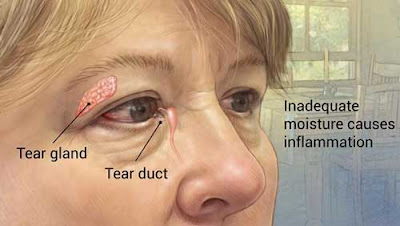Dry eye disease is an eye condition that are experiencing a shortage of the liquid due to volatile tears or tear production is too little. Or it could be this disease is a chronic shortage of sufficient lubrication and moisture in the eye causing the sensation of dryness, itching and burning.
Tears are made of water, oil, mucus, antibodies, special proteins, and which has an important role to the eyes. Water and oil provides moisture and lubrication, while mucus, antibodies, proteins and prevent infection. All these substances are secreted by special glands around the eyes. However, a few things can cause an imbalance in the water system of the eye, so that the supply of tears are not enough.
How to treat dry eye?
Treatment for dry eye only helps to control the symptoms, but there is no cure. Some people may have a recurrent dry eye symptoms during their lifetime.You should discuss treatment options with your eye care specialist. Treatment for dry eye may include:
- Artificial tears. Cases of mild to moderate dry eye can usually be handled with lubricating eye care, such as artificial tear drops, gels, and ointments. However, artificial tears is the main therapy for dry eye complaints because overcome very similar to natural tears. Artificial tears are sold freely on the market without having to use the recipes. Drops of tears a lot of its kind and one brand is not necessarily suitable for you. It's good to experiment to find a cure drops which are most effective for you. If you have chronic dry eye, it is recommended to use artificial tears even when you feel there is no problem. Avoid artificial tears with preservatives if you need to apply it more than four times a day or treated with chemicals that cause blood vessels to constrict.
- Eye drops. Some eye drops contain preservatives to prevent harmful bacteria grow in the bottle the drug. If your symptoms require you use eye drops more than six times a day, we recommend that you use the eye drops preservative-free. This is important especially if the doctor has to tell you that you have a severe dry eye symptoms. Preservatives are used in large amounts or over a period of time (months or yearly) can damage the delicate cells on the surface of the eye or cause inflammation. If you wear soft contact lenses (softlens), you may also need to use a lubricant free of preservatives, because preservative residues will stick to a contact lens and eye damage.
- Wear glasses. Select the reading glasses or sunglasses that fit close to the face or that have a side shield to help slow down the evaporation of tears from the surface of the eye. , Air Purifier to filter out dust and other particles can help prevent dry eye. A humidifier can also help add humidity to the air. If you are a contact lens wearer, changing the type of lens or limiting how often you use it usually will help ease the symptoms of dry eye. In addition, you can try replacing the lens cleaning solution or lubricating drops are preservative-free.
- Avoid dry conditions. Make sure your eyes to get enough rest when performing activities that require you to use the eyes in a long period. Apply medicated eye drops when doing this routine.
- Drinking water and insufficient intake of nutrients. Drinking plenty of water will help keep the mucous membranes keep your eyes moist. Try to eat more foods rich in omega-3 fats — flax seed, walnuts, and fatty fish such as salmon and cod.
- Do not rub the eye. Try to blink more often when you are reading, writing, driving, or work in front of the monitor to spread tears evenly all over the surface of the eye. In addition, avoid rubbing the eyes too hard, which can aggravate your symptoms.

0 comments:
Post a Comment